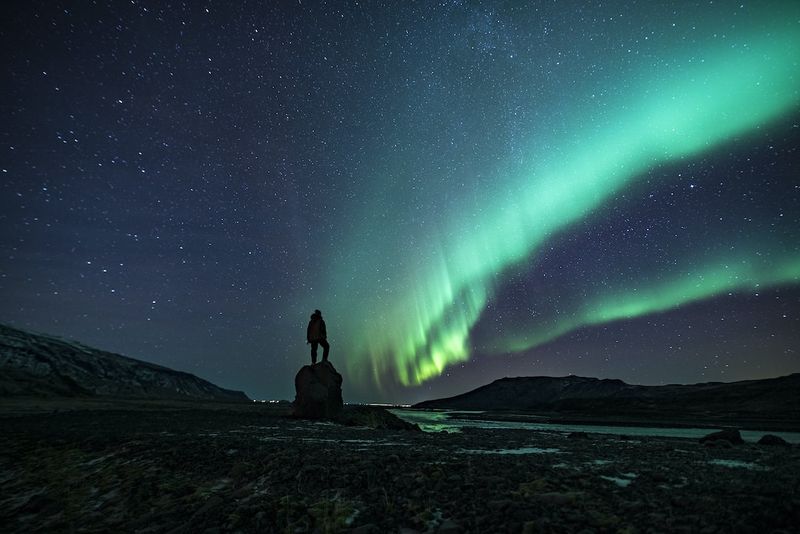The Northern Lights: A Mesmerizing Natural Phenomenon
The northern lights, also known as the aurora borealis, have captivated skywatchers for centuries. This awe-inspiring display of light occurs when the sun sends energy and particles towards Earth, often through an eruption called a coronal mass ejection. As the particles interact with Earth’s magnetic field, they create a mesmerizing dance of colors in the night sky.
Aurora Season is Here
As we approach the equinox, the northern lights are making their presence known once again. This week, there is a chance for skywatchers to witness the enchanting curtains of light as far south as New York and Idaho. Some scientists even suggest that the activity may extend down to Illinois or Oregon.
Reports of sightings have already come in from Wisconsin and Manitoba, showcasing the allure of this celestial spectacle. If weather conditions permit, one may be able to witness the northern lights with bare eyes or capture them through a camera lens.
Aurora Forecast
Brilliant auroras are generated during geomagnetic storms, caused by the temporary disturbance of Earth’s protective magnetic shielding due to solar particles. The strength of these storms is rated from G1 (minor) to G5 (extreme). The official forecast by NOAA’s Space Weather Prediction Center predicts a moderate (G2) storm, which could bring the aurora as far south as New York and Idaho.
However, space weather scientist Tamitha Skov does not rule out the possibility of a stronger G3 storm, potentially creating aurora sightings as far south as Illinois and Oregon. It is worth noting that earlier this year, a severe G4 storm surprised scientists, leading to sightings as far south as Arizona.
The weather conditions in the northern United States appear to be favorable for aurora viewing, with clear skies expected in most regions. The only exceptions are northern New England, where overcast skies may obstruct viewing, and the Upper Midwest, where patchy cloud cover could pose a challenge.
Where and What to Expect
The visibility and appearance of the aurora borealis depend on the strength of the geomagnetic storm, as well as the latitude and altitude of the observer. Different colors correspond to different elements excited in Earth’s atmosphere.
Red light is emitted when oxygen atoms are excited and located more than 120 miles above the surface. Green light is emitted from oxygen atoms between 60 and 120 miles above the surface. Excited nitrogen atoms result in pink or purple colors below 120 miles. Higher latitudes typically experience more intense auroras in greens and purples, while lower latitudes tend to see more reds.
The Philosophy and Wonder of the Northern Lights
The northern lights have long held a mystical and spiritual significance in many cultures. They inspire both awe and wonder, offering a reminder of the beauty and vastness of the natural world.
From a philosophical standpoint, the northern lights can serve as a humbling reminder of humanity’s place in the universe. They remind us that there is so much beyond our own little corner of existence, and that we are just a tiny part of a much larger cosmic dance.
These celestial displays also raise questions about the nature of perception and reality. The vivid colors and ethereal movements of the aurora borealis challenge our senses and push the boundaries of our understanding. They invite us to question what we see and how we interpret the world around us.
The northern lights are a reminder of the interconnectedness of all things. They are a visible representation of the relationship between our sun, Earth’s atmosphere, and the magnetic field. They remind us that we are all part of a delicate balance, and that our actions on Earth can have far-reaching effects.
An Invitation to Witness and Reflect
If you have the opportunity to witness the northern lights this week, embrace the chance to connect with the awe and wonder of the natural world. Take a moment to step outside, look up at the night sky, and soak in the beauty and grandeur of this celestial phenomenon.
Reflect on the philosophical questions the northern lights evoke. Consider the interconnectedness of all things and the impact we have on our environment. It is an opportunity to deepen our appreciation for the intricate web of life on Earth and to take action to protect and preserve our planet for future generations.
In the face of an uncertain and rapidly changing world, the northern lights serve as a reminder that there is still much beauty and marvel to be found. They awaken our sense of wonder and inspire us to explore, question, and embrace the mysteries of the universe.
This article was written by , a current affairs commentator for The New York Times.

<< photo by Jonatan Pie >>
The image is for illustrative purposes only and does not depict the actual situation.
You might want to read !
- Northen Lights Spectacle Set to Illuminate 17 US States in the Coming Week
- “Chasing the Northern Lights: A Rare Spectacle Possibly Coming to Montana”
- Kevin Stefanski’s Future with Browns Tied to Deshaun Watson’s Uncertain Destiny in Canadian Football
- Lamenting the Tragic Loss: Revelations from the Wife and Witness of the Gillette Stadium Fan
- Browns RB Nick Chubb sustains knee injury, putting season in jeopardy
- “The Dominance of Zhang Weili: A Spectacular Display of Skill and Tenacity at UFC 292”
- “Spotting the Spectacular Green Comet: A Guide to Catching a Celestial Wonder”
- Explore the Celestial Delights: Witness the Majestic Great Square of Pegasus Galloping Through the Night Sky
- Pas la peine de sortir voir la superlune bleue ce soir: ce n’est pas si exceptionnel que ça
Title: “La superlune bleue: une hype sans réelle importance?”
- Super Blue Moon: A Spectacular Celestial Event Lights Up the Night Sky in Canada
- Exploring Australia’s Long-Awaited Return of the Super Blue Moon in August




